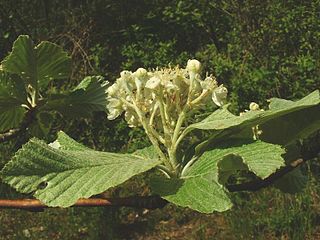
The whitebeams are members of the family Rosaceae, comprising a number of deciduous simple or lobe-leaved species formerly lumped together within Sorbus s.l. Many whitebeams are the result of extensive intergeneric hybridisation involving the genera Sorbus, Aria, Torminalis and Chamaemespilus. As an effect, they are commonly apomicts and many have very restricted ranges. The best known species is the common whitebeam, a columnar tree which grows to 25 m (82 ft) tall by 10 m (33 ft) broad, with clusters of white flowers in spring followed by speckled red berries in autumn (fall).

Karpatiosorbus latifolia is a species of whitebeam that is endemic to the area around Fontainebleau, south of Paris in France, where it has been known since the early eighteenth century.
The Arran whitebeams are species of whitebeam endemic to the island of Arran, Ayrshire, Scotland.
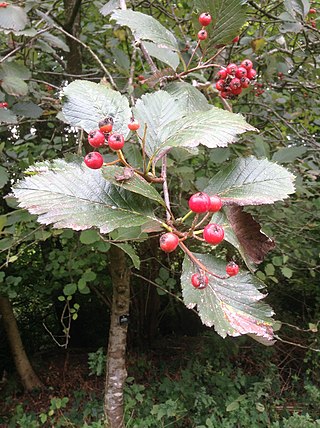
Hedlundia anglica, the English whitebeam, is a species of whitebeam tree in the family Rosaceae. It is endemic to Ireland and the United Kingdom, with an entire British population estimated at 600 individuals.

Hedlundia arranensis, sometimes referred to as the Scottish or Arran whitebeam, is a species of plant in the family Rosaceae. It is endemic to the island of Arran in Scotland.

Aria eminens, commonly known as the round-leaved whitebeam, is a species of plant in the family Rosaceae. It is endemic to Great Britain and is threatened by habitat loss.
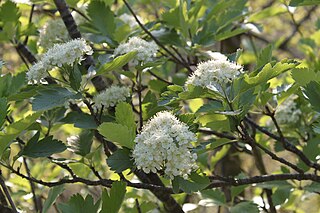
Hedlundia leyana, commonly known as Ley's whitebeam, is a species of small tree which is endemic to two sites in southern Wales. It is thought to have arisen by hybridisation between the rowan and a member of genus Aria.
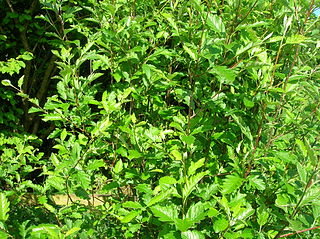
Hedlundia pseudofennica, also called Arran service-tree or Arran cut-leaved whitebeam, is a species of plant in the family Rosaceae. Endemic to the Isle of Arran in Scotland, it is threatened by habitat loss. It is thought to be a naturally occurring hybrid between H. arranensis and Sorbus aucuparia, probably with additional backcrossing with S. aucuparia. Hedlundia arranensis is itself a hybrid between Aria rupicola and S. aucuparia. Apomixis and hybridization are common in some groups of Sorbus species.

Aria edulis, the whitebeam or common whitebeam, is a species of deciduous tree in the family Rosaceae.

Hedlundia hybrida, the Swedish service-tree, Finnish whitebeam, or oakleaf mountain ash, is a species of whitebeam native to Norway, eastern Sweden, south-western Finland, and locally in Latvia.

Alniaria alnifolia, also called alder-leafed whitebeam, Korean whitebeam, or Korean mountain ash, Korean: 팥배나무; RR: Patbaenamu; MR: p'atpaenamu; lit. 'red bean pear tree' Chinese: 水榆花楸; pinyin: shui yu hua qiu; lit. 'water elm rowan', is a species of whitebeam native to eastern Asia in eastern and northern China, Taiwan, Korea and Japan.

Hedlundia minima, commonly known as the lesser whitebeam or least whitebeam, is a deciduous shrub in the rose family Rosaceae. It belongs to the genus Hedlundia, which includes species that have arisen from a hybridisation between members of the genus Sorbus (rowans) and members of genus Aria (whitebeams). It is an apomictic microspecies that reproduces only asexually, and is endemic to Wales.

Karpatiosorbus admonitor, previously classified as Sorbus admonitor and also called the Watersmeet whitebeam, is a species of whitebeam tree found in Devon, United Kingdom. It is known only from the Watersmeet Valley at Lynton, with two stray plants growing on the coast above Sillery Sands, Countisbury. It has also been nicknamed the "no parking whitebeam" in some newspapers.

Karpatiosorbus devoniensis is known by the English name of Devon whitebeam and formally as Broad-leaved Whitebeam. When the fruit was reported as sold at Barnstaple Pannier Market the name French Eagles was used, apart from 1929 when they were reported as eagle-berries. When the trees were reported as seen growing wild on botanical walks they were referred to as French Hails. Broad-leaved white-beam, which was the common name until Devon Whitebeam took over, was used once in 1907.
Karpatiosorbus houstoniae, or Houston's whitebeam, is a hybrid of two deciduous trees: the common whitebeam and the Bristol whitebeam. Only a single example of the hybrid is known to exist, at the Avon Gorge in Bristol, England. The only specimen grows on a cliff below Stokeleigh Camp at Leigh Woods in North Somerset and cannot be accessed without ropes.

Aria graeca, also known as the Greek whitebeam and fan-leaved service-tree, is a species of whitebeam, in the rose family (Rosaceae).
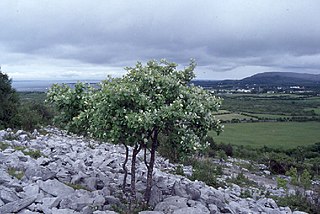
Aria hibernica, commonly known as Irish whitebeam, is a species of whitebeam endemic to Ireland. It occurs in most counties, usually as scattered individuals, or in small groups.

Aria porrigentiformis, commonly known as the grey-leafed whitebeam, is a species of whitebeam endemic to England and Wales.

Hedlundia is a genus of plants in the rose family. They are shrubs or small trees that have a hybrid origin involving crosses between Aria and Sorbus sensu stricto. There are about 48 species are distributed across central, western and southern Europe, Scandinavia, Turkey, the Caucasus, Crimea, and also central Asia. The term Hedlundia was published in 2017.

















